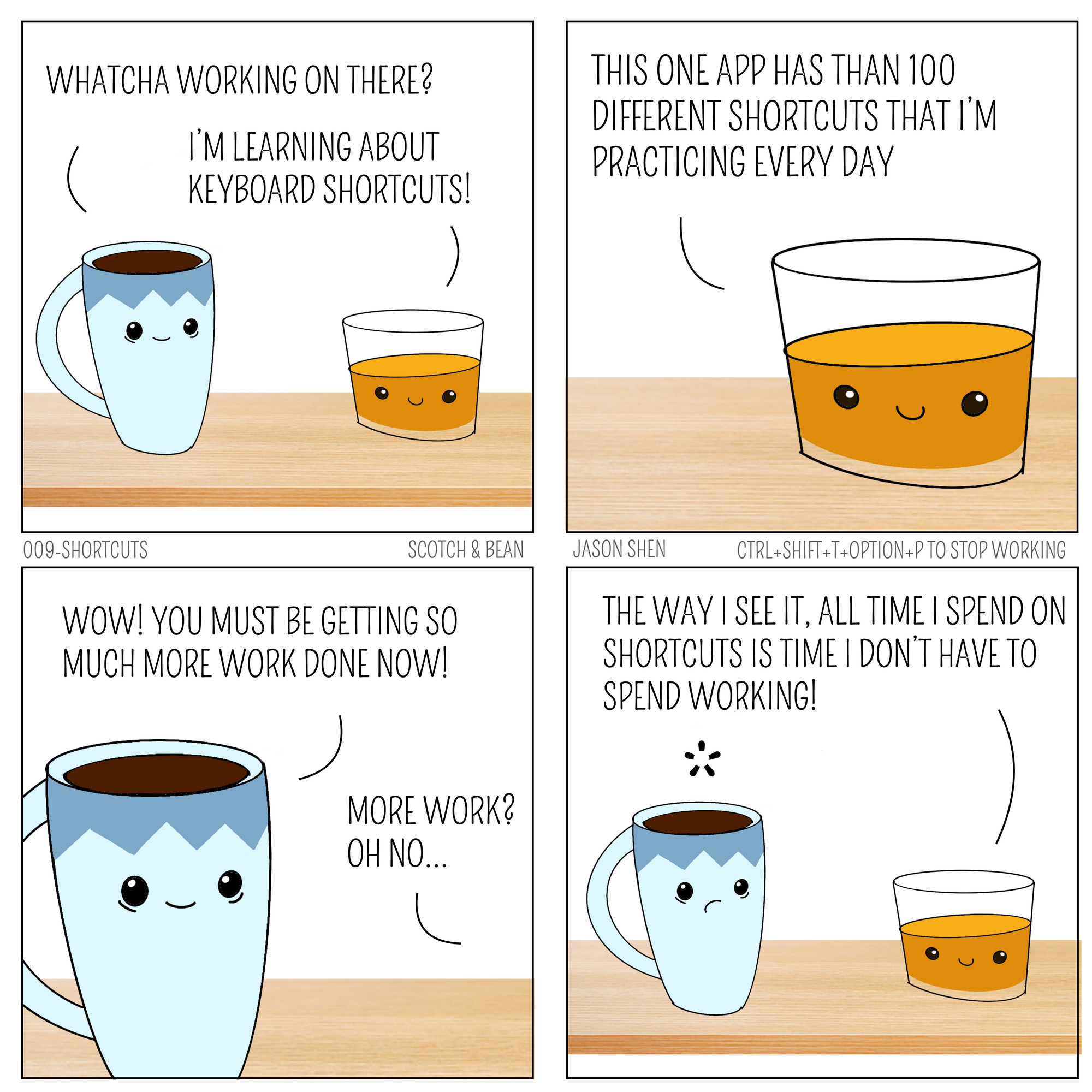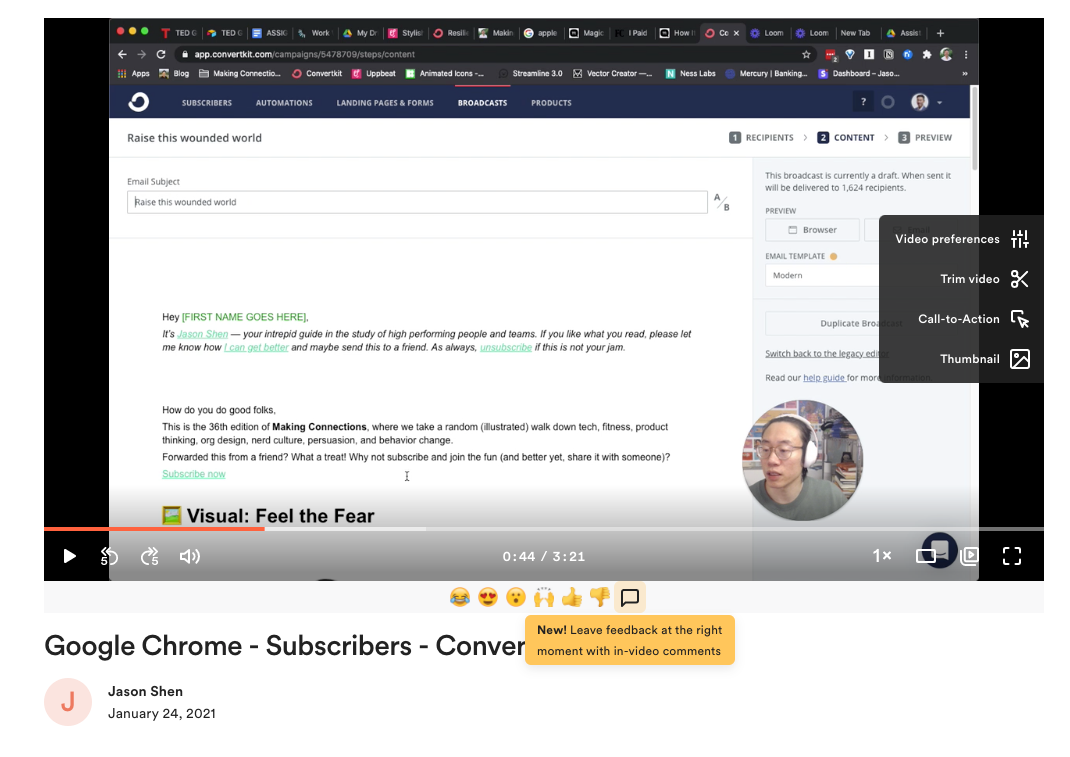Oh hello there,
This is the 41th edition of Making Connections, where we take a random (illustrated) walk down tech, fitness, product thinking, org design, nerd culture, persuasion, and behavior change.
Like what you see? Why not bring someone to the party?
🖼 Misusing Shortcuts

Confession: I pay for Superhuman but I only use a handful of shortcuts.
🧠 MAYA: Most Advanced Yet Acceptable

After posting a tweet about the benign violation humor spectrum (as referenced in MC012), I was pointed to the idea of “most advanced yet acceptable” by @andyfossett.
That led to an article in The Atlantic called The Four-Letter Code to Selling Just About Anything, which is an excerpt of the book Hitmakers: The Science of Popularity in an Age of Distraction. The article tells the story of Raymond Loewy, aFrench industrial designer, and how his work and ideas played pivotal role in shaping the American aesthetic.
Loewy would do more than almost any person in the 20th century to shape the aesthetic of American culture. His firm designed mid-century icons like the Exxon logo, the Lucky Strike pack, and the Greyhound bus. He designed International Harvester tractors that farmed the Great Plains, merchandise racks at Lucky Stores supermarkets that displayed produce, Frigidaire ovens that cooked meals, and Singer vacuum cleaners that ingested the crumbs of dinner...The famous blue nose of Air Force One? That was Loewy’s touch, too. After complaining to his friend, a White House aide, that the commander in chief’s airplane looked “gaudy,” he spent several hours on the floor of the Oval Office cutting up blue-colored paper shapes with President Kennedy before settling on the design that still adorns America’s best-known plane.
While this seems obvious, making stuff look better (and updating it regularly) took time to sink in as a business practice. The idea that you gotta switch things up every year, whether it’s the Ford Fusion 2021 edition or the iPhone 121, is pretty wild but also a great win for consumerism.
To acquaint himself with the deficiencies of Pennsylvania Railroad trains, Loewy traveled hundreds of miles on the speeding locomotives. He tested air turbulence with engineers and interviewed crew members about the shortage of toilets. A great industrial designer, it turns out, needs to be an anthropologist first and an artist second: Loewy studied how people lived and how machines worked, and then he offered new, beautiful designs that piggybacked on engineers’ tastes and consumers’ habits.
This guy was like a UX researcher, designer, product manager, and technical architect all in one!
The preference for familiarity is so universal that some think it must be written into our genetic code. The evolutionary explanation for the mere-exposure effect would be simple: If you recognized an animal or plant, that meant it hadn’t killed you, at least not yet. But the preference for familiarity has clear limits. People get tired of even their favorite songs and movies. They develop deep skepticism about overfamiliar buzzwords. In mere-exposure studies, the preference for familiar stimuli is attenuated or negated entirely when the participants realize they’re being repeatedly exposed to the same thing. For that reason, the power of familiarity seems to be strongest when a person isn’t expecting it.
We need things to be familiar (safe) but not too familiar (possibility for discovery).
In 2014, a team of researchers from Harvard University and Northeastern University wanted to know exactly what sorts of proposals were most likely to win funding from prestigious institutions such as the National Institutes of Health—safely familiar proposals, or extremely novel ones? They prepared about 150 research proposals and gave each one a novelty score. Then they recruited 142 world-class scientists to evaluate the projects. The most-novel proposals got the worst ratings. Exceedingly familiar proposals fared a bit better, but they still received low scores. “Everyone dislikes novelty,” Karim Lakhani, a co-author, explained to me, and “experts tend to be overcritical of proposals in their own domain.” The highest evaluation scores went to submissions that were deemed slightly new. There is an “optimal newness” for ideas, Lakhani said—advanced yet acceptable.
That’s where the MAYA term comes from: most advanced yet acceptable. I would be this finding holds true for startup pitches too.
The original version of Discover Weekly was supposed to include only songs that users had never listened to before. But in its first internal test at Spotify, a bug in the algorithm let through songs that users had already heard. “Everyone reported it as a bug, and we fixed it so that every single song was totally new,” Ogle told me. But after Ogle’s team fixed the bug, engagement with the playlist actually fell. “It turns out having a bit of familiarity bred trust, especially for first-time users,” he said. “If we make a new playlist for you and there’s not a single thing for you to hook onto or recognize—to go, ‘Oh yeah, that’s a good call!’—it’s completely intimidating and people don’t engage.” It turned out that the original bug was an essential feature: Discover Weekly was a more appealing product when it had even one familiar band or song.
I disliked Discover Weekly for this exact reason. To be honest, I still don’t give it a fair shot, but I should try again.
In her 2013 memoir cum cultural critique, Sleepless in Hollywood, the producer Lynda Obst mourned what she saw as cult worship of “pre-awareness” in the film and television industry. As the number of movies and television shows being produced each year has grown, risk-averse producers have relied heavily on films with characters and plots that audiences already know. Indeed, in 15 of the past 16 years, the highest-grossing movie in America has been a sequel of a previously successful movie (for example, Star Wars: The Force Awakens) or an adaptation of a previously successful book (The Grinch). The hit-making formula in Hollywood today seems to be built on infinitely recurring, self-sustaining loops of familiarity, like the Marvel comic universe, which thrives by interweaving movie franchises and TV spin-offs.
The world is complicated and life is hard enough. Sometimes we just want to watch something we already know and understand with a slight twist. I don’t think there’s anything necessarily wrong with that. We are going to make movies about Batman and Mulan and Romeo and Juliet for the end of time.
Several music critics have used videos like “4 Chords” to argue that pop music is derivative. But I think Raymond Loewy would disagree with this critique, for two reasons. First, it’s simply wrong to say that all I–V–vi–IV songs sound the same. “Don’t Stop Believin’ ” and “No Woman, No Cry” don’t sound anything alike. Second, if the purpose of music is to move people, and people are moved by that which is sneakily familiar, then musicians—like architects, product designers, scholars, and any other creative people who think their ideas deserve an audience—should aspire to a blend of originality and derivation. These songwriters aren’t retracing one another’s steps. They’re more like clever cartographers given an enormous map, each plotting new routes to the same location.
Nothing is truly original. Everything follows a pattern or has a historical precedent. To some degree, copyright, patents, and domain URL’s stifle our ability to reinvent old ideas. But I’m sure humanity will find a way to keep being creative, even those new ideas are only somewhat different.
Read the whole thing: The Four-Letter Code to Selling Just About Anything (theatlantic.com)
👉 Loom (Put your face on screen recordings)

This seems like an obvious one, but I know a lot of people haven’t heard yet of Loom an awesome product for making quick screen recordings of things. The innovation of loom is that you can insert your own face onto the screen recording, so it’s less soulless and more engaging.
I’ve been using it to create video guidelines (rather than writing out detailed step-by-step instructions) for virtual assistants with various tasks, for instance formatting this newsletter for a different platform. You can also use it to demo a new feature, or explain a document or presentation. It generates a hosted link so you don’t have to worry about uploading a file somewhere.
That’s it for this week!
-J
👨🏻💻 About Me
Jason Shen is an entrepreneur and business leader passionate about technology and human resilience. His past startups have reimagined transportation, recruiting, and gaming; backed by notable investors at Y Combinator, Techstars, and Amazon. As an operator, he’s built products and led teams at companies like Facebook, Etsy, and the Smithsonian.
Jason has written about productivity, resilience as well as the future of work in publications like Fast Company, VOX, TechCrunch and has spoken at events at TED, Google and The White House where his ideas have reached millions. He lives in Brooklyn with his wife, two kettlebells, and many piles of books.
What are we going to do when we hit iPhone 20? I hope they reboot the franchise at some point. After all, we skipped 9 right?

